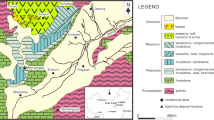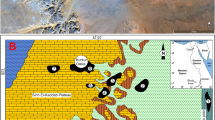Abstract
The lacustrine Sucker Creek Formation (Miocene) of eastern Oregon includes unaltered vitric tuffs as well as tuffs altered to the following diagenetic fades: (1) bentonite, (2) interbedded bentonite and opal-CT, (3) K-clinoptilolite, and (4) Ca-clinoptilolite. Bentonite beds contain Fe-rich smectite (8–10 wt. % Fe2O3), quartz, plagioclase, and Ca-clinoptilolite. Opal-CT-rich layers contain inorganic silica (opal-CT), Fe-rich smectite, and minor diatoms. K-clinoptilolite beds typically contain clinoptilolite that can be extremely K-rich (≤7.6 wt. % K2O), opal-CT, smectite, plagioclase, and K-feldspar. This diagenetic facies also includes smectitic tuff and unaltered tuff. Ca-clinoptilolite beds contain Ca-clinoptilolite, quartz, K-feldspar, smectite, and illite.
Based on its chemistry and mineralogy, the bentonite appears to have been derived from dacitic volcanic ash. Chemical considerations and the close spatial relationship between beds of bentonite and opal-CT suggest that the diagenetic alteration of glass to smectite provided silica to the adjacent opal-CT beds. Based on the presence of late-stage Ca-clinoptilolite, alteration appears to have proceeded in a relatively closed chemical system.
Based on the composition of preserved vitric tuff, the zeolitic tuffs appear to be derived from rhyolitic ash, which diagenetically altered in an open hydrologic system and produced vertical zonations in mineralogy. In this model, bentonite horizons at the top of the K-clinoptilolite diagenetic fades formed by reaction of volcanic glass with dilute fluids that had a relatively low (Na+ + K+ + Ca2+)/H+ activity ratio and \({\rm{a}}_{\rm{{H}}_4{\rm{SiO}_4}}\) , whereas the underlying K-clinoptilolite beds formed from reactions between glass and dilute fluids having a higher (Na+ + K+ + Ca2+)/H+ activity ratio and \({\rm{a}}_{\rm{{H}}_4{\rm{SiO}_4}}\) . Unaltered vitric ash between these beds may represent zones of higher permeability that inhibited secondary mineral alteration. Ca-clinoptilo-lite-rich beds appear to have undergone alteration similar to K-clinoptilolite-rich beds as well as to have been subjected to later, low-temperature (perhaps 75°–150°C) hydrothermal alteration which enhanced cation exchange in the zeolite and formed quartz from opal-CT.
Similar content being viewed by others
References
Appleman, D. E. and Evans, H. T., Jr. (1973) Indexing and least-squares refinement of powder diffraction data: U.S. Dept. of Commerce Natl. Tech. Serv. Publ. PB 216–188, 62 pp.
Bayliss, P. (1986) Quantitative analysis of sedimentary minerals by powder X-ray diffraction: Powd. Diff. 1, 37–39.
Boles, J. R. and Surdam, R. C. (1979) Diagenesis of volcanogenic sediments in a Tertiary saline lake; Wagon Bed Formation, Wyoming: Amer. J. Sci. 111, 832–853.
Boles, J. R. and Wise, W. S. (1978) Nature and origin of deep-sea clinoptilolite: in Natural Zeolites: Occurrence, Properties, Use, L. B. Sand and F. A. Mumpton, eds., Pergamon Press, Elmsford, New York, 235–243.
Broxton, D. E., Bish, D. L., and Warren, R. G. (1987) Distribution and chemistry of minerals at Yucca Mountain, Nye County, Nevada: Clays & Clay Minerals 35, 89–110.
Drever, J. I. (1988) The Geochemistry of Natural Waters: Prentice Hall, Englewood Cliffs, New Jersey, 437 pp.
Fisher, R. V. and Schmincke, H.-U. (1984) Pyroclastic Rocks: Springer Verlag, New York, 472 pp.
Gottardi, G. and Galli, G. (1985) Natural Zeolites: Springer Verlag, New York, 409 pp.
Hay, R. L. (1963) Stratigraphy and zeolitic diagenesis of the John Day Formation of Oregon: Calif. Univ. Pub. Geol. Soc. 42, 199–262.
Hay, R. L. (1966) Zeolites and zeolitic reactions in sedimentary rocks: Geol. Soc. Amer. Spec. Pap. 85, 130 pp.
Hay, R. L. (1977) Geology of zeolites in sedimentary rocks: in Mineralogy and Geology of Natural Zeolites, F. A. Mumpton, ed., Reviews in Mineralogy 4, Mineral. Soc. Amer., Washington, D.C., 53–64.
Hay, R. L. and Guldman, S. G. (1987) Diagenetic alteration of silicic ash in Searles Lake, California: Clays & Clay Minerals 35, 449–457.
Hay, R. L., Pexton, R. E., Teague, T. T., and Kyser, T. K. (1986) Spring-related carbonate rocks, Mg clays, and associated minerals in Pliocene deposits of the Armagosa Desert, Nevada and California: Geol. Soc. Amer. Bull. 97, 1488–1503.
Hay, R. L. and Sheppard, R. A. (1977) Zeolite in open hydrologic systems: in Mineralogy and Geology of Natural Zeolites, F. A. Mumpton, ed., Reviews in Mineralogy 4, Mineral. Soc. Amer., Washington, D.C., 93–102.
Hoffman, J. (1976) Regional metamorphism and K-Ar dating of clay minerals in Cretaceous sediments of the disturbed belt of Montana: Ph.D. dissertation, Case-Western Reserve University, Cleveland, Ohio, 266 pp.
Jones, B. F. (1965) The hydrology and mineralogy of Deep Springs Lake, Inyo County, California: U.S. Geol. Surv. Prof. Pap. 502-A, 56 pp.
Kittleman, L. R. (1973) Guide to the geology of the Owyhee region of Oregon: Univ. Oregon Mus. Nat. Hist. Bull. 21, 61 pp.
Kittleman, L. R., Green, A. R., Hagood, A. R., Johnson, A. M., McMurray, J. M., Russell, R. G., and Weeden, D. A. (1965) Cenozoic stratigraphy of the Owyhee region, southeastern Oregon: Univ. Oregon Mus. Nat. Hist. Bull. 1, 45 pp.
Leppert, D. (1990) Developments in applications for southeast Oregon bentonites and natural zeolites: in Proc. 25th Forum of Geol. of Ind. Min., R. P. Geitgey and B. F. Vogt, eds., Oreg. Dept. of Geol. and Min. Ind. Spec. Pap. 23, 19–23.
Murata, K. J. and Larson, R. R. (1975) Diagenesis of Miocene siliceous shales, Tremblor Range, California: U.S. Geol. Surv. J. Res. 3, 553–566.
Reynolds, R. C. (1989) Principles and techniques of quantitative analysis of clay minerals by X-ray powder diffraction: in CMS Workshop Lectures, Vol. 1, Quantitative Mineral Analysis of Clays, D. R. Pevear and F. A. Mumpton, eds., The Clay Minerals Society, Evergreen, Colorado, 4–36.
Ross, C. S. and Hendricks, S. B. (1945) Minerals of the montmorillonite group: U.S. Geol. Surv. Prof Pap. 205B, 77 pp.
Shepard, A. O. and Starkey, H. C. (1966) The effects of exchanged cations on the thermal behaviour of heulandite and clinoptilolite: Int. Mineral. Assoc. Vol., Mineral. Soc. India, 155–158.
Sheppard, R. A. and Gude, A. J., 3rd (1968) Distribution and genesis of authigenic silicate minerals in tuffs of Pleistocene Lake Tecopa, Inyo County, California: U.S. Geol. Surv. Prop. Pap. 597, 38 pp.
Sheppard, R. A. and Gude, A. J., 3rd (1973) Zeolites and associated authigenic silicate minerals in tuffaceous rocks of the Big Sandy Formation, Mohave County, Arizona: U. S. Geol. Surv. Prof. Pap. 830, 36 pp.
Slaughter, M. and Earley, J. W. (1965) Mineralogy and geological significance of the Mowry bentonites, Wyoming: Geol. Soc. Amer. Spec. Pap. 83, 116 pp.
Surdam, R. C. (1977) Zeolites in closed hydrologic systems: in Mineralogy and Geology of Natural Zeolites, F. A. Mumpton, ed., Reviews in Mineralogy 4, Mineral. Soc. Amer., Washington, D.C., 65–91.
Surdam, R. C. and Parker, R. B. (1972) Authigenic aluminosilicate minerals in the tuffaceous rocks of the Green River Formation, Wyoming: Geol. Soc. Amer. Bull. 83, 689–700.
Taylor, M. W. and Surdam, R. C. (1981) Zeolite reactions in the tuffaceous sediments at Teels Marsh, Nevada: Clays & Clay Minerals 29, 341–352.
Wiles, D. B. and Young, R. A. (1981) A new computer program for Rietveld analysis of X-ray powder diffraction patterns: J. Appl. Crystallogr. 14, 149–151.
Author information
Authors and Affiliations
Additional information
Deceased, August 19, 1989.
Rights and permissions
About this article
Cite this article
Altaner, S.P., Grim, R.E. Mineralogy, Chemistry, and Diagenesis of Tuffs in the Sucker Creek Formation (Miocene), Eastern Oregon. Clays Clay Miner. 38, 561–572 (1990). https://doi.org/10.1346/CCMN.1990.0380601
Received:
Accepted:
Published:
Issue Date:
DOI: https://doi.org/10.1346/CCMN.1990.0380601




